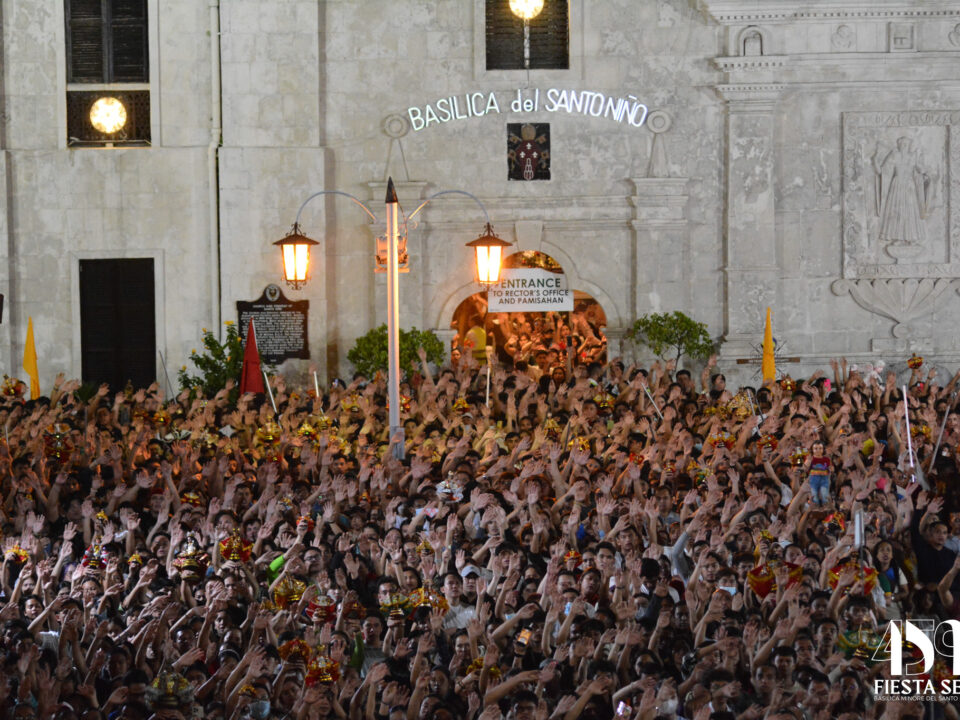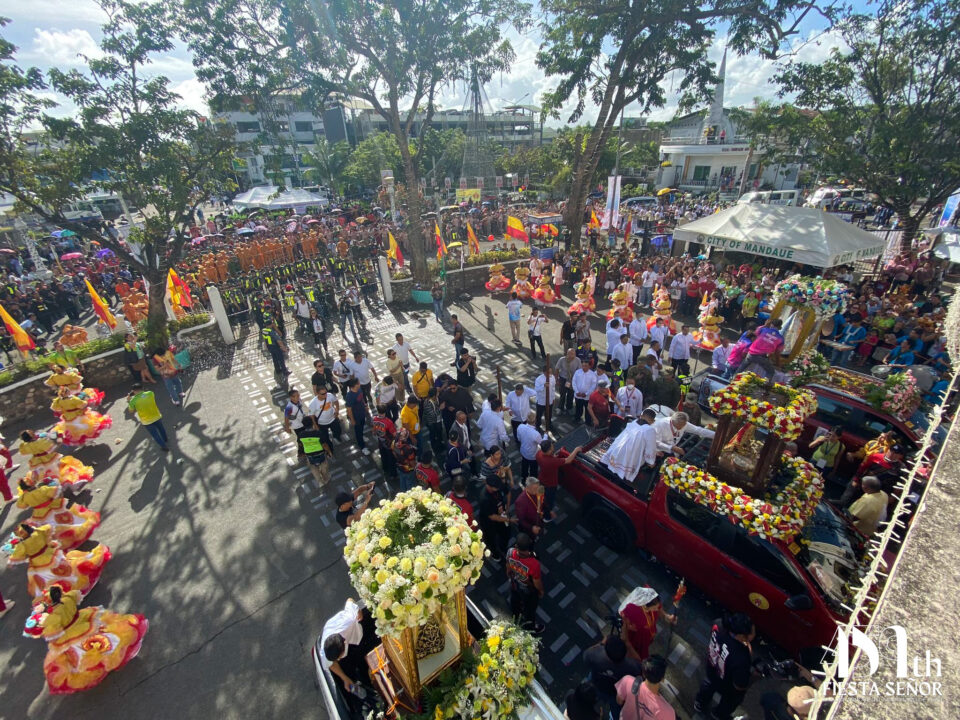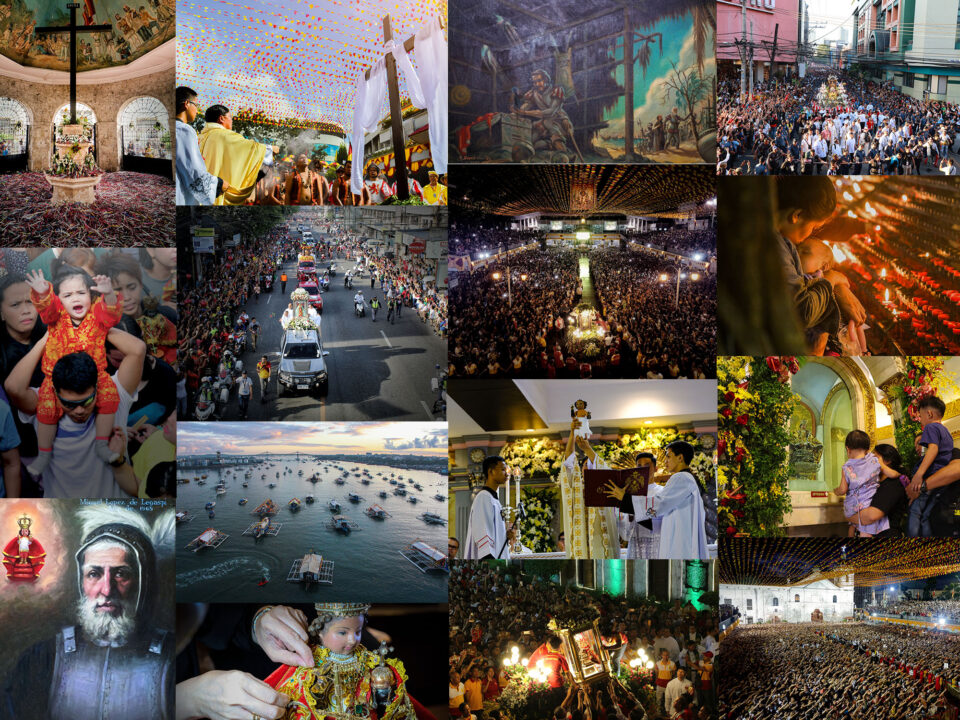The Institutionalization of the Santo Niño Traditional Religious Sinulog
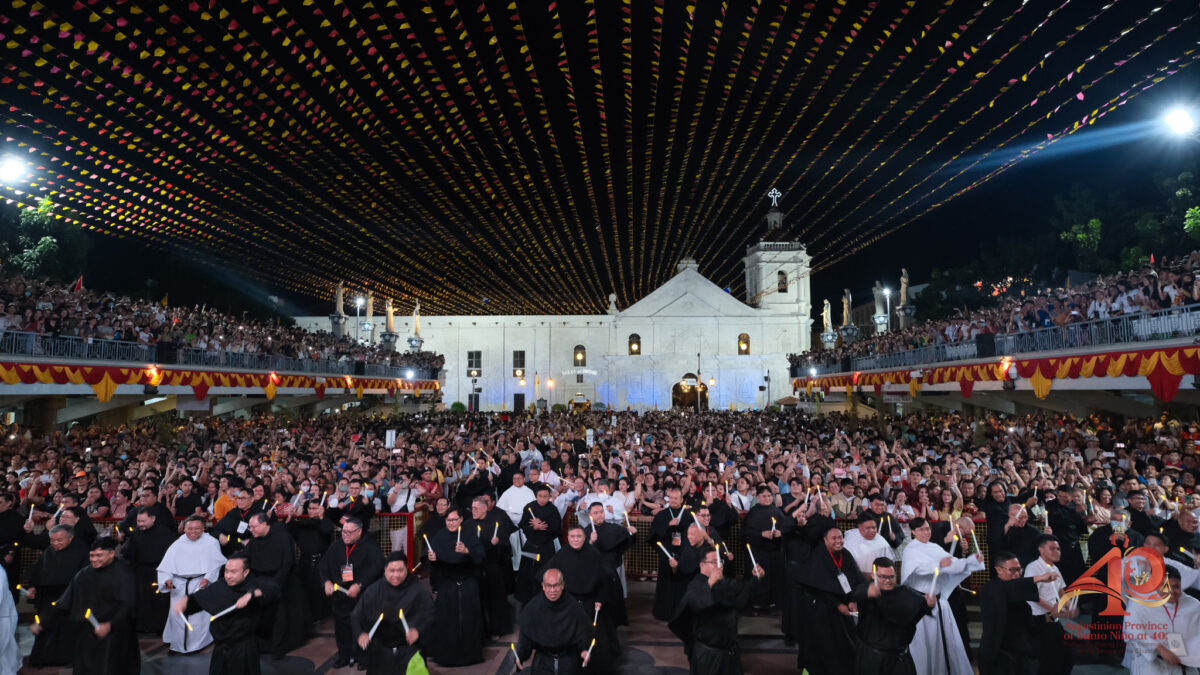
Traditional Religious Sinulog
On the eve of the celebration of the Feast of Santo Niño (every third Sunday of January), after the pontifical mass that usually starts at 6:00 pm or after the arrival from Solemn Foot Procession, devotees dance and raise their hands to offer their prayers to the Child Jesus, shouting “Pit Senyor” and “Viva Pit Senyor!”. It is a one-hour solemn dance offering and it is called Traditional Religious Sinulog held at the grounds of the Santo Niño Pilgrim Center. Then, what makes this traditional religious Sinulog different from the Sinulog Mardi Gras or Sinulog Festival held the next day?
Rev. Fr. Felmar Castrodes Fiel, SVD, who has been assigned in Cebu since 2014, gives the detailed explanation in his blog of the difference between the Sinulog Mardi Gras and the traditional religious sinulog, that says:
The Sinulog Mardi Gras held every feast day, which has become a huge tourist attraction, is a civic, cultural, and religious affair and is organized mainly by the Sinulog Foundation, Inc. with the strong support of the Cebu City government. The performers come from various schools, private organizations, artists, and local government units in and outside Cebu, with complex and beautiful choreographies to the bouncy and animated beats of symphonic drums and other musical instruments under the supervision and training of professional and renowned choreographers and instrumentalists, perform before the hundreds of thousands, if not millions, of spectators lining the parade route and before several panels of judges strategically placed along the route.
The other sinulog, the Traditional Religious Sinulog, is much different from the first. In the words of Fr. Andrew Batayola, OSA, “Sinulog does not just happen every January. It is a daily event around the Basilica del Santo Nino de Cebu, sans the color and festivities. The performers are not dancing in groups but in solitude; not young and bouncy but old and hunched. Their acts are not done with complicated choreographies but with simple moves; not with thunderous beats with murmured requests. They don’t perform before an audience but before a miraculous icon, not for an award but for a favor.”[1]
Despite the difference in the respective organization that spearheads two activities, one thing is in common, everything is an offering to the beloved child Jesus, the Santo Niño. Another difference is how these two sinulog versions are conducted and held.
Pit Senyor!: the Voice of the devotees
During the annual Fiesta Señor in January though, this simple sinulog assumes a bigger volume and impact because it is now done by a bigger number of devotees after the Visperas Pontifical Mass (celebrated after the arrival of the solemn foot procession).
For decades, if not centuries, this kind of traditional religious sinulog after the Visperas Mass was unorganized and was done by devotees who remain in front of the Basilica facing the main altar behind the closed main door.[2] The Sinulog was initiated prayerfully by individuals or by family or by groups of friends, or simply joined in by other devotees, for several minutes, murmuring their petitions in-between loud pleas of “Pit Senyor” and “Viva Pit Senyor!”
Later, in the late 1990’s, this unorganized traditional religious sinulog dance had transformed into something more organized and meaningful, where the entire community of devotees collectively pray to God together in a ritualistic dance.
This beautiful transformation was triggered by an incident – an argument arising from differences of opinion between two Augustinian friars after the 5:30 PM Visperas Mass of Fiesta Señor on January 20, 1996, the last year of the term of the Rector of the Basilica, Fr. Bernardo Coleco, OSA. The two Augustinians were Fr. Coleco himself and Fr. Agustin “Boy” Ty, OSA. Others present at the incident just a few feet from the two Augustinians were Fr. Jose “Joe” Quilongquilong, SJ, BMSN Extraordinary Ministers of Communion Raul Alugar, Francisco Argoncillo, and Paulino Yabao, and the sound technician at the time. The incident took place on the left side of the altar just outside the door of the sound system control room.
A few minutes after the final hymn was sung at the close of the Visperas Pontifical Mass, devotees who did not leave the Pilgrim Center started to pray with lighted candles by dancing the Sinulog, some of them who were near the Basilica were facing the Basilica, and the others were facing the altar of the Pilgrim center, dancing to the different beats of two or three drums played separately in various points of the quadrangle by some devotees.
Shortly after, while the altar area was being cleared and cleaned, the sound technician played the mardi gras sinulog on the CD player. Unexpectedly, the devotees, as if in one collective group, danced the sinulog along with the mardi gras sinulog. Those outside the street started coming back to the Pilgrim Center and filled the quadrangle to join the sinulog. Those in the altar were touched by what they witnessed, as people were praying then in loud voices cried “Pit Senyor” and “Viva Pit Senyor!” together.
It was at this point that Fr. Coleco was observed to be running from the Basilica passing through the left side of the Pilgrim center while repeatedly shouting “Stop the music!” When he reached the sound system control room, he directed the sound technician to stop the music because it was not religious, hence not suitable for the occasion. Fr. Ty butted in and asked Fr. Coleco not to stop the music because the devotees were praying with the sinulog. An exchange of words ensued due to the differences of opinion. Finally, Fr. Coleco invoked his authority as rector of the Basilica and commanded the sound technician to obey him. In the end, the sound technician obeyed Fr. Coleco and stop playing the CD.
For a few seconds, there was utter silence. Then the stunned devotees roared their protest to the stopping of the sinulog music, with some shouting that they came from afar to honor the Holy Child and pray through the sinulog. Then somebody (most probably one of the three lay ministers) went to the podium and announced that the devotees could still do their sinulog individually or in small groups in front of the Basilica while the Pilgrim Center would be cleared and cleaned in preparation for the Sunday fiesta. It took some time before the devotees cooled down and slowly cleared the Pilgrim Center.
After the incident, Fr. Quilongquilong and the three lay ministers pondered on the incident and what they saw. Fr. Quilongquilong opined that it would be good for the Basilica to have the traditional religious sinulog done as a community, collectively not individually by the devotees.
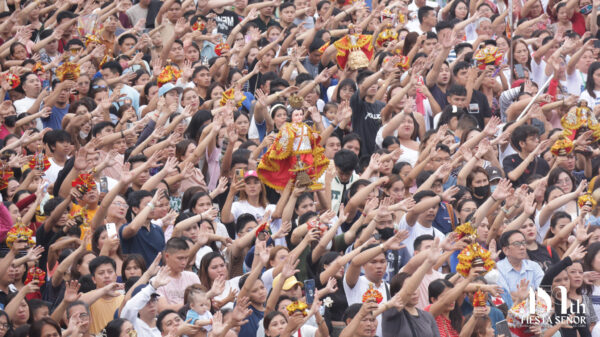
The Institutionalization of the Traditional Religious Sinulog
When preparations were done for the next Fiesta Señor in 1997 under the newly appointed rector of the Basilica, Fr. Bernardino Ricafrente, OSA, and lay ministers Raul Alugar and Paulino Yabao mentioned the incident in 1996 and proposed the suggestion of the Fr. Quilongquilong that it was the proper time that the Basilica should organize and lead the communitarian traditional religious sinulog. The lay ministers emphasized that the sinulog should be led by the Augustinians themselves. Without hesitation, Fr. Ricafrente approved the proposal, directing further that since the two lay ministers were endorsing the proposal, they would be the one to implement and lead it. The two agreed until such time some Augustinians would be ready and capable to lead the sinulog.
Thus, the first communitarian version of the traditional religious sinulog was “institutionalized” during the Fiesta Señor of 1997, January 18, Visperas day.
Since its institutionalization, the music used in the traditional religious sinulog is a live performance of drums accompanied by mentioning of petitions and prayers. The UC Drum and Bugle Corps volunteered to provide music until 2006 with the support of benefactors. Starting in Fiesta Señor 2007, the traditional sinulog was turned over to another group, led by an Augustinian novice, and the group engaged the services of another group of drummers until 2009.
In 2010, there was a transition from the use of live performance of percussion instruments or drums to recorded music for the traditional religious sinulog. In the preparations for the 2010 fiesta, two lay ministers, Paulino Yabao and Raul Alugar, suggested to Fr. Rodolfo Bugna, OSA that the music be recorded so that all devotees, inside and outside the Pilgrim Center could equally hear the sinulog beat at a more comfortable volume or intensity when played over the Pilgrim Center’s sound system. The music used was based on Mike Hanopol’s sinulog song which contains the traditional basic sinulog beat.
Initially the communitarian Traditional Religious Sinulog is held every after the Visperas Pontifical Mass that would last for almost an hour and continued until 2010. However, in the following years a significant development happened in the practice of dancing the traditional religious sinulog.
In 2011 Festa Señor, by the term of Fr. Bugna, OSA, the rector, and the Augustinian Community of the Basilica, permitted a recorded shorter version of the traditional religious sinulog (4 minutes) to be the final hymn of all the Masses during the Fiesta Day. It was also in this Fiesta Señor year that a recorded short traditional sinulog was danced for the first time after the Opening salvo mass.
In addition, during the term of Fr. Jonas Mejares, OSA, (2012-2016) the Rector and the Augustinian Community of the Basilica, extended the shorter version of the traditional religious sinulog (4 minutes) to be the final hymn of the last masses during the entire novena days.
The reason for having the traditional sinulog in more masses is to give opportunity to thousands of devotees who could not join the Visperas traditional sinulog. Not all are able to participate in the biggest community dance of the sinulog due to limited space at the pilgrim center.
When COVID-19 struck the country and when the world was literally stopped in 2021, the practice of the traditional religious sinulog was also paused. On the fourth day of the novena, the Augustinian friars announced the cancellation of physical mass celebrations in the remaining days of the Fiesta Señor 2021. In the following year, 2022, the new normal, traditional sinulog was not still danced and rather replaced by one activity outside the basilica, which is the inter-city and municipality mobile procession.
“The communitarian Traditional Religious Sinulog is by its name religious in nature closely connected to the Holy Mass and organized by the Augustinian Community. But more importantly, what makes the Traditional Religious Sinulog different from the other is that all devotees together with the bishops, Augustinians, priests and the religious, who number in tens of thousands who participate and attend the Pontifical Mass situated in the Pilgrim Center, the Basilica and the surrounding streets, dance the Sinulog to the simple beats of the ordinary drums as one praying community, raising their communitarian and individual petitions together when they praise and thank God, and seek His guidance and blessings when they now pray more emphatically what they usually murmur “Pit Senyor! Viva, Pit Senyor!” This is what happens at the end of the Saturday Pontifical Mass, which sometimes lasts an hour. Surprisingly though, even after the community religious sinulog has ended, there are still multitudes of devotees, by groups, families or individually who continue the sinulog offering.”[3]
In an editorial from The Freeman in 2009[4], the Sinulog Festival has grown and became too commercialized and politicized. Queenie Bronce claims when Sinulog became commercialized it contributed to the natural growth of the festivity and it claimed the title “mother of festivities”. Consequently, with this transformation it overshadowed the true meaning of the celebration, which is an offering to the child Jesus, the Santo Niño.
The traditional religious sinulog danced at the Basilica Minore del Santo Niño makes a difference in corresponding to the invitation to remain closely rooted to its original meaning.
The narrative of how the traditional religious sinulog began at the Basilica is a response to the transformation observed by the devotees in 1996 even before 2009. It was like the work of the Holy Spirit, the vox populi, when people are seeking for religious meaning of the grandest celebration in Cebu. It was neither planned nor organized but rather the voice of the hearts of the devotees.
Since that historic incident in 1996 and looking at how the traditional sinulog has gathered thousands of people at the Pilgrim Center, it could only be a testimony of how the devotees love the child Jesus. It is a form of worship, petition, praise, and thanksgiving that makes it relevant to the devotees.
In an interview with the Archbishop Emeritus of the Archdiocese of Cebu, Ricardo Cardinal Vidal, in 2013, published on The Freeman, he said, for “447 years now, we have been saying , ‘Pit Senyor!’ to mean ‘we worship you, Senyor Sto. Nino,’ ‘we praise you,’ ‘we petition you,’ and ‘we thank you’… . ‘Pit Senyor’ was not just a Cebuano way of greeting a fellow devotee. It was and will always and everywhere be a form of prayer to Senyor Sto. Nino de Cebu by every Filipino who has been baptized like ‘Reina Juana’, and who vowed to behave accordingly as a God-fearing citizen and as a law-abiding Christian.”[5]
Viva Pit Senyor!
Atty. Paul Yabao and Genesis Labana, OSA
General Structure of the Sinulog
Viva, Senyor Sto. Nino! Viva, Pit Senyor!
Viva, Senyor Sto. Nino! Viva, Pit Senyor!
- Kitang tanan magsinulog. Kitang tanan mag Pit Senyor.
Mag-ampo ta nga magsinulog. Kitang tanan mag Pit Senyor.
Refrain:
Pit Senyor! O Pit Senyor! Kitang tanan mag Pit Senyor.
Pit Senyor! O Pit Senyor! Kitang tanan mag Pit Senyor.
- … Pit Senyor! (6x)
Refrain:
Pit Senyor! O Pit Senyor! Kitang tanan mag Pit Senyor.
Pit Senyor! O Pit Senyor! Kitang tanan mag Pit Senyor.
- … Pit Senyor! (2x)
Ibayaw ta atong pag-ampo. Kitang tanan magsinulog.
Isampit ta atong pag-ampo. Kitang tanan mag Pit Senyor.
Refrain:
Pit Senyor! O Pit Senyor! Kitang tanan mag Pit Senyor.
Pit Senyor! O Pit Senyor! Kitang tanan mag Pit Senyor.
- … Pit Senyor! (6x)
Refrain:
Pit Senyor! O Pit Senyor! Kitang tanan mag Pit Senyor.
Pit Senyor! O Pit Senyor! Kitang tanan mag Pit Senyor.
- … Pit Senyor! (6x)
Refrain:
Pit Senyor! O Pit Senyor! Kitang tanan mag Pit Senyor.
Pit Senyor! O Pit Senyor! Kitang tanan mag Pit Senyor.
- … Pit Senyor! (6 x)
Refrain:
Pit Senyor! O Pit Senyor! Kitang tanan mag Pit Senyor.
Pit Senyor! O Pit Senyor! Kitang tanan mag Pit Senyor!
VIVA SENYOR SANTO NINO!
Prayers for Long Traditional Religious Sinulog
(to be made after 2 or 3 or 4 sets)
Prayer 1
(PRAYER TO STO. NINO . . . )
O Senyor Sto. Nino,
you are our king and our God,
we worship you.
You are our strong defender,
we turn to you.
You are the patron of Cebu
and the Philippines,
we come to you.
You have made extraordinary
wonders through your
miraculous image
in these chosen islands,
remember us.
Look down at this poor soul
that comes to you for help.
Lead us with Your wisdom;
discipline us with your truth;
console us with your tenderness,
protect us with your might.
Amen.
Prayer 1-a
(LET US PRAY . . .)
We consecrate today
our thoughts to you,
only with you shall they be occupied;
our words, only of you shall they speak;
our sufferings, that we may endure them for your sake.
We beg you Snr. Sto. Nino,
illumine our understanding,
kindle our will,
cleanse our body,
sanctify our soul.
We wish what you wish,
because you wish, as you wish,
as long as you wish.
Grant us, Snr. Sto. Nino,
that we may feel love
toward you,
be strict toward ourselves,
be zealous toward our fellowmen,
and rightly despise the things of the world.
Amen
Prayer 1-b
(LET US PRAY . . .)
Help us to overcome sensuality
with strict discipline,
avariciousness with generosity,
anger with gentleness,
indolence with zealous industry.
Make us wise in counsel,
courageous in danger,
patient in adversity,
humble in prosperity.
Teach us, dear Santo Nino,
how worthless is the world,
how sublime is heaven,
how brief is time,
how long is eternity.
Grant us, lastly,
that we may remember you,
adore you, love you
and serve you here on earth
that we may be happy
with you forever and
ever in heaven. Amen.
Prayer 2
(LET US PRAY . . .)
O Santo Nino, who has said,
“ask and you shall receive;
seek and you shall find;
knock and it shall be
opened unto you,”
Give we beseech you, to us who ask,
the gift of your divine love,
that we may love you
with our whole heart,
in word and work,
and never cease from showing forth
your praise.
Make us, O Lord,
to have a perpetual fear
and love of Your Holy Name,
for you never fail
to govern them
whom you do solidly
establish in Your love,
through Jesus Christ our Lord.
Amen.
Prayer 3
(Concluding Prayer)
O miraculous Santo Nino, prostrate before your sacred Image,
we beseech you to cast a merciful look on our troubled hearts.
Let Your tender love, so inclined to pity,
be softened at our prayers, and grant us that grace
for which we ardently implore you.
Take from us all unbearable affliction and despair.
For your sacred infancy’s sake
hear our prayers and send us consolation and aid
that we may praise you, with the Father
and the Holy Spirit, forever and ever. Amen.
Final blessing (Fr. Rector or Augustinian)
As Rector/_________ of the Basilica Minore del Sto. Nino de Cebu, I, together with
(our beloved Archbishop and Bishops, as well as
all my brother priests present, will now impart the final blessing.…
THE LORD BE WITH YOU….
MAY THE ALMIGHTY, MERCIFUL AND LOVING GOD BLESS ALL OF YOU, ALL THE STO. NINO DEVOTEES, AND ALL YOUR FAMILIES AND LOVED ONES,
IN THE NAME OF THE FATHER+, THE SON+, AND THE HOLY SPIRIT+.
Amen.
FORMAT OF TRADITIONAL RELIGIOUS SINULOG
- OPENING
Atong sugdan ang atong sinulog karon diha sa Ngalan sa Amahan, sa Anak ug sa Espiritu Santo. Amen.
(After Amen, play the CD… and while waiting exclaim: VIVA PIT SENYOR! as many times as necessary until the sinulog music starts.
(In case of a long sunulog, say this in-between sinulog music: VIVA PIT SENYOR! as many times as necessary until the sinulog music starts.
- SINULOG PETITIONS
- PRAYER EVERY AFTER 2 OR 3 OR 4 SETS OF SINULOG PETITIONS
CLOSING
(If a priest is available:)
Taposon ta kining sinulog diha sa katapusang panalangin . . . .
(If there is no priest:)
Taposon ta kining sinulog diha sa Ngalan sa Amahan, sa Anak ug sa Espiritu Santo. Amen.
(After the blessing and/or sign of the cross)
Masipang pakpak kang Snr. Sto. Nino…
Daghang salamat ug maayong gabii kanatong tanan. PIT SENYOR!
SINULOG PETITIONS[6]
(Revised 2022)
(1)
Himayaon ka, Dios
Pagadaygon ka, Dios
Pasayloa kami
Kaloy-i kami
Lamdagi kami
Panalipdi kami
Kang mama kini.
Kang papa kini.
Kang lola kini
Kang lolo kini
Sa pamilya kini
Sa mga paryente kin
Sa mga higala kin
Sa dili higala kini
Sa biktima sa bagyo kini
Sa way kapuy-an kini
Sa way makaon kini
Sa way kahigdaan
Sa way tubig kini
Sa way kuryente kini
Sa mga nagtabang kini
Sa mga rescuers kini
Sa mga first aiders kini
Sa emergency workers kini
Sa matinabangon kini
Sa maggihatagon kini
(2) (Pit Senyor – all)
Pagadaygon ka Dios
Pasayloa kam
Tabangi kami
Lig-ona kami
Giyahi kami
Agaka kami
Puypoya among kaguol
Puypoya among kabalaka
Wagtanga ang among kahadlok
Ilikay kami sa katalagman
Ilikay kami sa mga dautan
Ilikay kami sa mga sakit
Ilikay kami sa covid-19
Panalipdi kami
Ayuha ang mga masakito
Tabangi ang may covid-19
Panalipdi ang mga doctor
Panalipdi ang mga nurses
Panalipdi ang mga frontliners
Panalipdi ang mga way bakuna
Sa biktima sa bagyo kini
Sa biktima sa sunog kini
Sa biktima sa mga calamidad
Sa mga gigutomn kini
Sa way kapuy-an kini
Sa pasalamat kini
(3)
(Pit Senyor – all)
Pagadaygon ka Dios
Pasayloa kami
Tabangi kami
Lig-ona kam
Giyahi kami
Agaka kami
Puypoya among kaguol
Puypoya among kabalaka
Panalipdi kami sa covid-19
Tabangi ang may covid-19
Ayuha mga masakiton
Panalipdi mga doctor
Panalipdi mga nurses
Panalipdi
ENDNOTES:
______________________________________________________
[1] Fr. Felmar Castrodes Fiel, SVD, “Frequently Asked Questions on Fiesta Señor 2015”, in Felmar’s Missionary Journey, Date Published: January 9, 2015, Date Accessed: June 18, 2022), URL: https://fielsvd.wordpress.com/2015/01/09/frequently-asked-questions-on-fiesta-senor-2015/; This differentiation was originally part of the Media Kit given to the press in 2013 and 2014 regarding the frequently asked questions of the Fiesta Señor. The file is available in the rector’s office. Fr. Fiel posted this on his blog. The FAQs file was prepared by Atty. Paulino Yabao.
[2] “A year before the incident in 1996, while I was supervising the UC Chorus members in packing up their sound system and instruments used during the Holy Mass, I heard one of the devotees playing a drum and everybody danced Sinulog to the beat of the drum. The Sinulog was danced until guards announced the closure of the main gate. The latecomers continued to offer their sinulog outside the main gate in Osmeña Blvd. I learned from the old vendors and devotees that this was how sinulog had been done for years – spontaneous, personal, individual, unorganized but very candid and sincere.” This is an observation from Atty. Paul Yabao, which was written on November 15, 2012 sent to Rev. Fr. Ian-Narcissus Openia, OSA, chairman of the Committee on Liturgy of Fiesta Señor 2013, describing how the traditional religious sinulog started particularly the incident that happened on Fiesta Señor 1996.
[3] Ibid.
[4] Queenie Bronce, “Opinion: Commercialized and Politicized?” in The Freeman (Published on January 17, 2009), URL: https://www.philstar.com/opinion/2009/01/17/432130/commercialized-and-politicized, Date Accessed: June 18, 2022,
[5] Maria Eleonor Valeros, “Modern Journey on Traditional Mode” in The Freeman, published on January 19, 2013 (dated accessed: June 18, 2022, url: https://www.pressreader.com/philippines/the-freeman/20130119/281809986257972).
[6] See more petitions in separate document.
Texts highlighted in orange color are my addition. The rest is written by Atty. Paul Yabao.



